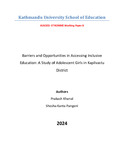
Please use this identifier to cite or link to this item:
https://hdl.handle.net/20.500.14301/448| Title: | Barriers and Opportunities in Accessing Inclusive Education: A Study of Adolescent Girls in Kapilvastu |
| Authors: | Khanal, Prakash Pangeni, Shesha Kanta |
| Citation: | Khanal,P. & Pangeni, S.K.(2024).Barriers and opportunities in accessing inclusive education: A study of adolescent girls in Kapilvastu. |
| Issue Date: | Sep-2024 |
| Publisher: | Kathmandu University School of Education |
| School: | SOED |
| Department: | DOEL |
| Level: | M.Phil. |
| Program: | Masters in Educational Leadership |
| Abstract: | The study emphasizes both the complexity of the difficulties adolescent girls' encounter and the potential for grassroots movements and educational programs to effect positive change. It emphasizes the significant impact inclusive education has on both individual and societal development, advancing the conversation about it. This study explores how teenage girls might obtain inclusive education in the Kapilvastu District, offering surprising insights into the transformative power of education. The struggles faced by Urmila, Akriti, and Tarabun show a range of issues, including ingrained gender stereotypes and financial constraints. Some strategies for reducing these barriers include empowerment programs, financial accessibility, inclusive curricula, awareness campaigns, lobbying, community involvement, and policy reforms. In revelations, it is emphasized how important it is to remove financial barriers to access all people and how outside help fosters growth for both the individual and the community. The advancement of inclusive education aims to counteract harmful customs and promote harmony among many caste groups. Through community involvement and inclusive initiatives, which change people and society, girls are provided crucial life skills and resilience. In conclusion, this study offers important insights about the chances of teenage girls attending inclusive schools. Anyone working to remove obstacles and encourage an inclusive, empowered learning environment will find it to be a comprehensive road map. The effects emphasize the need for specific empowerment initiatives, financial support networks, inclusive educational programs, awareness campaigns, and legislative changes. Together, these initiatives can help ensure that all adolescent girls attain their educational objectives and make positive contributions to society in the future. This study illustrates how empowerment through education may change the lives of adolescent females and the neighborhoods where they live. Keywords: Inclusive Education, Social Ecological Model, adolescents, barriers |
| URI: | https://hdl.handle.net/20.500.14301/448 |
| Appears in Collections: | Working Papers |
Files in This Item:
| File | Description | Size | Format | |
|---|---|---|---|---|
| Languae edited_Working paper 8 prakash Khanal- track changed (1).pdf | 210.93 kB | Adobe PDF |  View/Open |
Items in DSpace are protected by copyright, with all rights reserved, unless otherwise indicated.